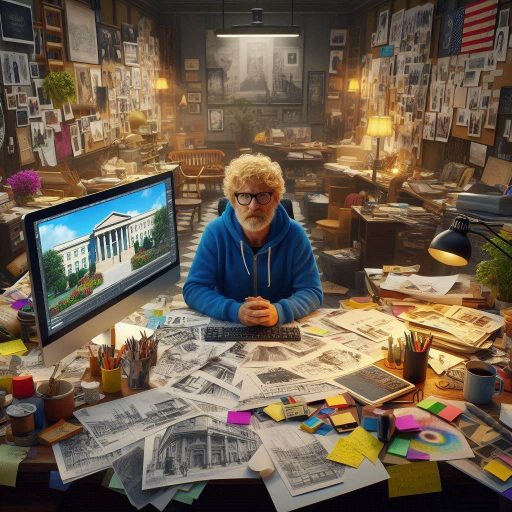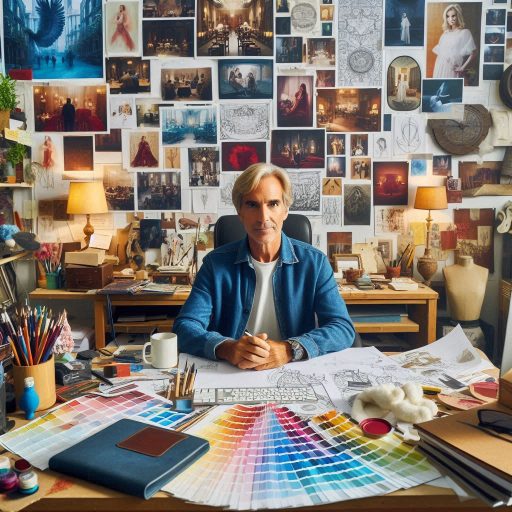Introduction
Creative blocks in advertising design refer to moments when ideas fail to flow, leaving designers feeling stuck and uninspired.
These blocks can manifest as a lack of motivation, difficulty generating new concepts, or an inability to visualize solutions.
Such obstacles can hinder an artist’s ability to produce compelling work that meets client expectations and aligns with campaign goals.
Overcoming creative blocks is crucial for producing effective advertising campaigns.
When designers struggle with creativity, they risk missing deadlines and disappointing clients.
Additionally, these blocks can stifle innovation and lead to uninspired designs that fail to engage audiences.
Creative blocks are common in the creative industry, affecting artists of all levels, from seasoned professionals to fresh graduates.
Many designers experience this challenge at some point in their careers, often feeling isolated in their struggle.
However, it is essential to remember that these blocks can be overcome with the right strategies.
Understanding that creative blocks are a natural part of the creative process can alleviate some pressure and anxiety associated with them.
Techniques such as taking breaks can provide a fresh perspective, allowing the mind to recharge.
Engaging in activities unrelated to design, such as exercise or exploring nature, can spark new ideas and stimulate creativity.
Understand the root cause of your creative block
Identify Factors Contributing to Your Creative Block
Stress is one of the most significant contributors to creative blocks.
When pressure builds, it can stifle your creativity.
Recognizing when stress affects your work can help you address it.
Consider taking breaks or practicing relaxation techniques to alleviate stress.
Fatigue also plays a crucial role.
Long hours and intense workloads can leave you mentally drained.
If you find it hard to generate new ideas, ensure you are getting enough rest.
Prioritizing sleep and downtime can recharge your creativity.
A lack of inspiration often leads to creative blocks.
Surround yourself with different forms of art, design, and media to stimulate your creativity.
Explore new sources of inspiration, like visiting galleries, reading, or watching films.
Exposure to diverse ideas can reignite your creative spark.
Lastly, fear of failure can paralyze your creative process.
You may worry about how others will perceive your work.
Acknowledging this fear is the first step toward overcoming it.
Shift your focus from the outcome to the creative process itself.
Reflect on Past Successful Projects
Reflecting on past successful projects can provide valuable insights.
Analyze what worked well and what made those projects successful.
Consider the techniques, tools, and approaches you used.
Identifying these elements can help you recognize what may be lacking in your current work.
Look for patterns in your successful projects.
Did you collaborate with others, or did you explore new styles? Understanding the conditions that fostered your creativity can guide your current efforts.
Additionally, evaluate the mindset you had during those projects.
Were you more relaxed or open to experimenting? Replicating that mindset can enhance your creative output.
Understanding the Root Cause for Targeted Solutions
By identifying the root cause of your creative block, you can develop targeted solutions.
For example, if stress is a significant factor, prioritize self-care.
Implement stress-reduction techniques like mindfulness or exercise.
Creating a more balanced routine can foster a healthier mindset.
If fatigue is an issue, schedule regular breaks and ensure you take time off.
Give yourself permission to step back from projects when needed.
This break can provide fresh perspectives and renewed energy.
For lack of inspiration, set aside time for creative exploration.
Engage in activities that excite you outside of work.
This exploration can inspire new ideas and stimulate your imagination.
Finally, to combat fear of failure, embrace a growth mindset.
Allow yourself to make mistakes and learn from them.
This shift in perspective can reduce pressure and foster creativity.
Basically, handling creative blocks in advertising design involves identifying contributing factors.
By reflecting on past successes and understanding the root causes, you can implement targeted solutions.
With these strategies, you can overcome creative blocks and enhance your design work.
Read: Breaking Down Iconic Movie Costumes
Take a break and refresh
Step Away from Your Work
Sometimes, the best solution is to step away from your work.
Engaging in activities that help clear your mind can be beneficial.
Going for a walk can stimulate your thoughts and promote clarity.
The change of scenery can spark new ideas as you observe your surroundings.
Meditation is another effective technique.
Taking a few minutes to breathe deeply and focus can enhance mental clarity.
This practice calms your mind and allows creative thoughts to surface.
Additionally, meditating can reduce stress and improve focus when you return to work.
Engaging in a creative hobby unrelated to your design work can also help.
Activities like painting, knitting, or playing music can free your mind.
These hobbies encourage different modes of thinking and foster innovative ideas.
They allow you to express yourself without the pressure of deadlines.
Give Yourself Permission to Take a Break
Giving yourself permission to take a break is crucial for creativity.
Designers often feel guilty about stepping away from projects.
However, a break can lead to better results in the long run.
Remind yourself that creative processes require time and space.
When you allow yourself to pause, you create room for fresh perspectives.
Returning to your project after a break can provide new insights.
You may notice aspects you missed or discover alternative approaches.
This rejuvenation often leads to enhanced creativity and improved design outcomes.
Taking Breaks Sparks New Ideas and Prevents Burnout
Taking regular breaks is essential for maintaining creativity.
Constantly pushing through can lead to burnout and fatigue.
By stepping away, you give your brain a chance to reset.
This reset is crucial for fostering new ideas.
Inspiration often strikes when you least expect it.
During breaks, you might find ideas bubbling up unexpectedly.
These moments can lead to breakthroughs that transform your project.
Incorporating short breaks into your routine can enhance productivity.
Research shows that regular intervals improve focus and cognitive function.
This practice keeps your mind sharp and ready for creative challenges.
Furthermore, breaks help maintain a healthy work-life balance.
A balanced lifestyle fosters overall well-being, leading to better creativity.
Prioritize self-care and allow yourself the freedom to recharge.
Therefore, handling creative blocks in advertising design requires intentional strategies.
Stepping away, engaging in different activities, and giving yourself permission to take breaks are crucial steps.
These practices not only spark new ideas but also prevent burnout, ensuring sustained creativity in your work.
Read: Freelance vs. In-House Costume Design Jobs
Experiment with different techniques
Try New Brainstorming Techniques
Brainstorming techniques can refresh your thinking and generate new ideas.
Mind mapping is an effective method to visualize thoughts and concepts.
Start with a central idea, then branch out into related topics.
This approach can help you explore connections you might overlook.
Sketching is another valuable technique.
Doodling ideas on paper can trigger new insights.
It allows you to visualize concepts quickly without overthinking.
Collaborating with others can also spark creativity.
Discussing ideas with colleagues or friends can provide new perspectives.
Engaging in brainstorming sessions encourages diverse input.
The exchange of ideas can inspire innovative solutions you may not have considered alone.
Surrounding yourself with creative individuals often leads to exciting breakthroughs.
Don‘t hesitate to seek feedback on your concepts as well.
Constructive criticism can refine your ideas and drive you forward.
Experiment with Different Mediums or Tools
Experimenting with various mediums or tools can stimulate creativity.
If you typically design digitally, try sketching by hand.
This shift can provide a fresh perspective on your work.
Alternatively, explore graphic design software that you haven‘t used before.
Learning new tools can unlock different creative possibilities and enhance your skills.
Consider experimenting with mixed media as well.
Combining traditional and digital techniques can lead to unique designs.
For example, create a collage using magazine cutouts, then digitize the results.
This blend of mediums encourages unconventional thinking and expands your artistic toolkit.
Engaging in different artistic practices can also be beneficial.
Try painting, photography, or even writing.
Exploring different forms of expression can inspire fresh ideas and approaches in advertising design.
These activities stimulate your creative muscles and promote a mindset open to experimentation.
Break Out of Your Usual Routine
Breaking out of your usual routine is essential for overcoming creative blocks.
By exploring new approaches, you can rekindle your inspiration.
Change your work environment to stimulate your senses.
A different setting can lead to new ideas and perspectives.
Take breaks to recharge your mind and spirit.
Stepping away from your work can provide clarity and new insights.
Engaging in physical activities, like walking or exercising, can enhance mental well-being.
A clear mind fosters creativity and helps you see challenges from different angles.
Lastly, set realistic goals for yourself.
Sometimes, the pressure to produce perfect work can stifle creativity.
Allow yourself the freedom to create without judgment.
Embrace the idea that not every concept needs to be groundbreaking.
In review, handling creative blocks in advertising design requires exploration and experimentation.
Trying new brainstorming techniques, experimenting with different mediums, and breaking routines can rejuvenate your creativity.
By adopting these strategies, you can overcome obstacles and continue producing impactful designs.
Read: Networking Events for Costume Designers
Seek inspiration from diverse sources
Look Outside of the Advertising Industry for Inspiration
One effective strategy is to look beyond the advertising industry for inspiration.
Art galleries showcase a wide array of creative expressions.
Visiting galleries allows designers to explore different artistic styles and techniques.
Observing how artists convey messages visually can spark new ideas.
Nature serves as another powerful source of inspiration.
The colors, patterns, and textures found in nature can ignite creativity.
Spend time outdoors to observe the beauty of the natural world.
Capture the essence of landscapes, plants, and animals in your design work.
Nature’s variety can inspire innovative concepts and approaches.
Films also offer rich visual narratives that can enhance creativity.
Watching movies exposes designers to diverse storytelling techniques and cinematography.
Analyze how filmmakers use visuals to evoke emotions and convey messages.
These insights can translate into more dynamic advertising campaigns.
Social media platforms like Pinterest and Instagram provide endless inspiration.
Explore trending designs, illustrations, and photography.
Follow artists, designers, and brands that resonate with you.
Curating a visual board of inspiring content can spark new ideas and concepts.
Engage with Content That Sparks Your Creativity
Engaging with content that excites you is crucial for overcoming creative blocks.
Whether it‘s books, podcasts, or documentaries, seek out materials that inspire you.
Reading about design history or listening to industry leaders can provide fresh perspectives.
These insights can help you think outside the box and challenge your creative boundaries.
Participate in creative workshops or online courses.
These experiences can introduce you to new techniques and collaborative environments.
Collaborating with other creatives often leads to unexpected ideas and solutions.
Surrounding yourself with inspiring individuals fosters a vibrant creative atmosphere.
Additionally, take time to engage in personal projects.
Create without the pressure of client expectations.
This freedom allows for exploration and experimentation.
As you create for yourself, you may discover innovative ideas that translate into your professional work.
Exposing Yourself to Diverse Sources of Inspiration
By exposing yourself to diverse sources of inspiration, you can overcome creative blocks.
The goal is to cultivate a rich pool of ideas that can fuel your creativity.
Embrace the process of exploration and remain open to new experiences.
Allow your mind to wander and connect seemingly unrelated concepts.
This connection often leads to unique advertising solutions that stand out.
Remember, creativity thrives on variety and exploration.
By actively seeking inspiration beyond the confines of advertising, you can invigorate your design process.
In short, creative blocks in advertising design are common challenges.
However, looking outside the industry for inspiration can lead to fresh ideas.
Engage with content that excites you and sparks your creativity.
By exposing yourself to diverse sources of inspiration, you can overcome these obstacles and generate innovative concepts for your advertising design.
Embrace the journey, and let your creativity flow!
Read: Famous Costume Designers in Hollywood

Set realistic goals and deadlines
Break Down Your Project into Smaller Tasks and Set Achievable Goals
Start by breaking down your project into manageable tasks.
Instead of viewing the entire project as a daunting challenge, focus on smaller components.
Identify specific elements you need to complete, such as research, sketching, or creating digital assets.
By doing this, you create a clear path forward, reducing feelings of overwhelm.
Next, set achievable goals for each task.
Define what success looks like for each component of your project.
For example, aim to finish the initial sketches by a specific date.
Having a clear goal provides direction and purpose.
This focus allows you to channel your creative energy into completing each task efficiently.
Establish Deadlines to Keep Yourself Accountable and Prevent Procrastination
Setting deadlines for each task is crucial.
Deadlines create a sense of urgency that can spur action.
Use tools like calendars or project management software to visualize your timeline.
This organization helps you track progress and stay on schedule.
When establishing deadlines, be realistic about your capabilities.
Consider how long each task will take and account for potential distractions.
Set intermediate deadlines to keep yourself accountable throughout the project.
This structure helps maintain momentum and discourages procrastination.
Transform Your Career Today
Unlock a personalized career strategy that drives real results. Get tailored advice and a roadmap designed just for you.
Start NowAdditionally, share your deadlines with colleagues or friends.
This external accountability can motivate you to meet your commitments.
Knowing others are aware of your timeline can encourage you to push through creative blocks.
By Setting Realistic Goals and Deadlines, You Can Stay Motivated
Setting realistic goals and deadlines keeps your creative process on track.
Focus on completing one task at a time.
This approach prevents feelings of being overwhelmed and fosters a sense of accomplishment.
Each completed task builds confidence and motivation, propelling you toward your final goal.
Consider implementing time management techniques, such as the Pomodoro Technique.
This method involves working for 25 minutes, then taking a 5-minute break.
Regular breaks prevent burnout and help maintain creativity.
During these breaks, engage in activities that inspire you, such as walking or listening to music.
Furthermore, reflect on your progress regularly.
Celebrate small victories, no matter how minor.
Acknowledging achievements can boost your motivation and inspire you to tackle the next task.
In essence, handling creative blocks in advertising design requires effective strategies.
Break down projects into smaller tasks and set achievable goals.
Establish deadlines to maintain accountability and prevent procrastination.
By focusing on one task at a time, you can stay motivated and overcome creative blocks.
This structured approach allows your creativity to flow and enhances your overall productivity.
Embrace failure and learn from mistakes
Understand That Creative Blocks Are a Natural Part of the Creative Process
Creative blocks often feel frustrating, but they are a natural part of the creative process.
Every designer faces moments of uncertainty and self-doubt.
Recognizing that these blocks happen to everyone can alleviate pressure.
Accepting this reality allows designers to approach their work with a healthier mindset.
Failure is not the end; it is a valuable opportunity for growth.
Each setback can provide insights that lead to better outcomes.
Designers should view creative blocks as stepping stones toward improvement.
By reframing failure in this way, they can cultivate resilience and adaptability.
When creative blocks arise, take a moment to reflect.
Analyze what may be causing the block and consider potential solutions.
Sometimes, stepping away from the project can offer fresh perspectives.
Allowing the mind to reset often leads to new ideas.
Embrace Mistakes as a Learning Experience
Mistakes are an inevitable part of the creative journey.
Instead of fearing them, embrace them as learning experiences.
Each mistake provides valuable lessons that can refine your ideas and techniques.
By analyzing errors, designers can identify areas for improvement.
When mistakes occur, avoid becoming discouraged.
Instead, view them as opportunities for exploration.
Experimenting with different approaches can lead to innovative solutions.
Embracing this mindset encourages risk-taking and creativity.
Journaling or sketching can help process mistakes.
Write down what went wrong and brainstorm alternative approaches.
This practice not only clarifies thoughts but also fosters creativity.
Over time, designers will develop a stronger problem-solving toolkit.
Additionally, sharing mistakes with peers can provide new insights.
Discussing challenges with fellow designers can offer fresh perspectives.
This collaborative approach can lead to innovative solutions and renewed motivation.
Adopt a Growth Mindset
Adopting a growth mindset is essential for overcoming creative blocks.
This mindset emphasizes the belief that skills and abilities can improve through effort.
Designers should focus on progress rather than perfection.
Embrace the idea that challenges are opportunities for learning and growth.
By cultivating a growth mindset, designers can shift their perspective.
Instead of seeing creative blocks as failures, view them as essential learning experiences.
This approach encourages experimentation and resilience in the face of obstacles.
Practice self-compassion during difficult moments.
Recognize that every designer faces challenges and that it‘s okay to struggle.
Treat yourself kindly and allow time for creativity to flow naturally.
Generally, creative blocks are a natural part of the advertising design process.
Embracing mistakes and adopting a growth mindset can empower designers.
By viewing setbacks as opportunities, designers can enhance their skills and creativity.
This proactive approach fosters continuous improvement and innovation in advertising design.
Collaborate with others
Seek Feedback from Colleagues, Mentors, or Friends
One effective way to combat creative blocks is to seek feedback.
Sharing your work with colleagues or mentors offers new perspectives.
They may see potential in your design that you overlooked.
Fresh eyes can identify strengths and weaknesses in your work.
Constructive criticism helps refine your ideas and enhances your design process.
Feedback can also inspire you to think differently.
Your colleagues may suggest approaches you hadn’t considered.
These insights can trigger new ideas and directions for your projects.
Engaging in discussions about your work creates a collaborative atmosphere.
This environment fosters creativity and encourages innovative thinking.
Don‘t hesitate to ask for opinions from friends outside the industry.
They can provide valuable insights into how your design resonates with the target audience.
Their perspectives may help you identify gaps in your messaging or visuals.
Embrace this feedback as an opportunity for growth rather than criticism.
Collaborate on Projects with Others
Collaboration is another powerful tool for overcoming creative blocks.
Working with other designers or professionals opens the door to new ideas.
Each collaborator brings unique experiences and expertise to the table.
This diversity can enrich your projects and inspire fresh concepts.
Engaging in collaborative brainstorming sessions can spark creativity.
Set aside time for group discussions to generate ideas without judgment.
Encourage all participants to contribute, creating a safe space for exploration.
This approach often leads to unexpected breakthroughs and innovative solutions.
Collaboration can also lighten the workload.
Sharing responsibilities allows everyone to focus on their strengths.
By dividing tasks, you can streamline the creative process and enhance productivity.
This teamwork helps you push through creative barriers more effectively.
Leverage Their Expertise and Creativity
When collaborating, leverage the strengths of your partners.
Each person may excel in different areas, such as typography, color theory, or digital tools.
Use their expertise to improve your work and expand your skill set.
Learning from others can reignite your passion for design.
Working with others also fosters accountability.
When you collaborate, you create a shared goal that encourages commitment.
This sense of responsibility can motivate you to overcome blocks.
You‘ll feel empowered to contribute actively and keep the creative momentum going.
In general, handling creative blocks in advertising design requires proactive strategies.
Seeking feedback from colleagues, mentors, and friends can provide fresh perspectives.
Collaborating on projects with others allows you to generate new ideas and share responsibilities.
By leveraging the expertise and creativity of your partners, you can break through creative barriers and reignite your passion for design.
Embrace collaboration as a pathway to innovation and success in your advertising endeavors.
Practice self-care and prioritize mental health
Pay Attention to Your Mental and Physical Well-Being
Your physical health significantly impacts your creativity.
Prioritize getting enough sleep each night.
Sleep rejuvenates your mind, improving focus and creative thinking.
Aim for seven to nine hours of quality sleep.
Additionally, maintain a balanced diet.
Eating nutritious foods fuels your brain, enhancing cognitive function.
Regular exercise also plays a vital role in creative health.
Physical activity boosts endorphins, reducing stress and improving mood.
Aim for at least 30 minutes of exercise most days.
This routine can be as simple as walking or doing yoga.
Even small bursts of activity can reinvigorate your mind and help combat creative blocks.
Practice Mindfulness Techniques
Mindfulness techniques can significantly reduce stress and anxiety.
Begin by incorporating deep breathing exercises into your daily routine.
Focus on inhaling deeply and exhaling slowly to calm your mind.
This practice centers your thoughts and prepares you for creative work.
Meditation is another effective mindfulness technique.
Set aside a few minutes each day to meditate.
This practice helps clear mental clutter and enhances focus.
Apps like Headspace or Calm can guide you through meditation sessions.
In addition to meditation, consider journaling.
Write down your thoughts and feelings to gain clarity.
This process can help you identify stressors contributing to your creative blocks.
By understanding these factors, you can develop strategies to address them.
Prioritize Self-Care for a Healthy Mindset
Prioritizing self-care is essential for cultivating creativity.
Make time for activities that bring you joy and relaxation.
Whether it‘s reading, painting, or spending time in nature, find what resonates with you.
Engaging in hobbies can spark inspiration and recharge your creative energy.
Create a daily routine that includes self-care practices.
Schedule breaks during work hours to avoid burnout.
Short walks or moments of quiet reflection can refresh your mind.
Set boundaries between work and personal life to maintain balance.
Connect with others for support and inspiration.
Engage in conversations with fellow creatives.
Sharing ideas and experiences can provide fresh perspectives and encouragement.
Collaboration can help you break through creative blocks and ignite new ideas.
Essentially, handling creative blocks in advertising design requires attention to mental and physical well-being.
Prioritize sleep, nutrition, and exercise to boost creativity.
Implement mindfulness techniques to reduce stress and gain clarity.
Lastly, prioritize self-care to cultivate a healthy mindset.
By focusing on these areas, you can overcome creative blocks and enhance your work in advertising design.
Embracing these practices will not only improve your creativity but also contribute to a more fulfilling creative journey.
Delve into the Subject: Typography Workshops and Courses for Beginners
Conclusion
Several key strategies can help you effectively handle creative blocks in advertising design.
First, taking regular breaks allows your mind to refresh and regain focus.
Stepping away from your work can provide clarity and new perspectives when you return.
Seeking inspiration from various sources, such as art, nature, or even different industries, can also spark fresh ideas and approaches.
Engaging with diverse content broadens your creative horizons, allowing you to think outside the box.
Collaboration with colleagues is another effective strategy that fosters creativity.
Sharing ideas and seeking feedback can generate new insights and solutions.
A brainstorming session with peers often leads to unexpected breakthroughs.
Additionally, establishing a structured routine can help maintain a creative flow, allowing you to allocate dedicated time for brainstorming and exploration.
Overcoming creative blocks is crucial for producing successful advertising campaigns.
When you push through these challenges, you enhance your ability to create impactful designs that resonate with audiences.
Ignoring creative blocks can lead to missed opportunities and stagnant ideas, ultimately hindering your professional growth.
I encourage you to apply these strategies in your daily work.
Experiment with different techniques to discover what works best for you.




